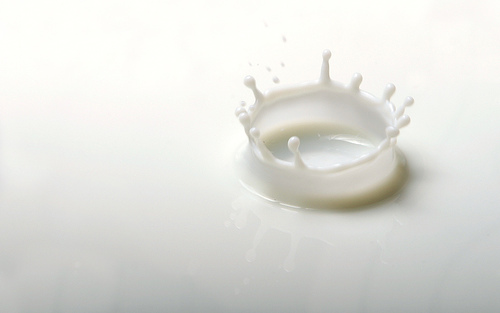Found in everything from cave paintings to King Tut’s tomb, this handmade substance was a predominate component in decorative art for at least a few millenia, until the industrial revolution came along. Casein, the protein found in milk, makes an extremely durable binder for pigments to adhere to most porous surfaces. The rustic finish is not usually desirable for fine art, and it fell out of favor all together with the advent of convenient, but far more volatile, canned paint. High demand in the home improvement market for water-based low or no VOC coatings has brought eco-friendly technology to mainstream retail stores, but I have yet to see it available in the small sizes that artists and crafters lean towards. Making your own milk paint can be an inexpensive, natural alternative to collecting a zillion little plastic bottles of mass produced polymers. If acrylics are not disposed of correctly, synthetic resins can seep into ground water. Although most craft paints are non-toxic and water-based, their manufacturing and shipping contribute to pollution as well. There are as many different ways to make milk paint as there are applications. It can be created quickly from dry powdered milk as needed by mixing 1 part powdered milk to 1 part water, and adding a color concentrate to achieve the desired shade. You could experiment with food coloring, Kool-Aid or cake dyes to start, but to go au natural, you’ll need pigments. I’ve listed some good tutorials and recipes below, as well as natural pigment suppliers. If I’m not mistaken, many of these pigments serve a dual purpose to dye fiber. I’ll be covering this subject in an upcoming post. So, consider the possibilities… create your own textile designs on organic cotton, brighten up some old furniture, turn plywood trash into an art piece, or give your pet rock a bit more personality. Whatever the application, this is an eco-friendly alternative for one of the most problematic commercial supplies in existence:
Milk Paint Recipe on Appropedia Fabric Milk Paint Instructions at Helium Powdered Tempera Milk Paint Recipe at eHow.com Milk Paint Supplies at NaturalPigments.com Milk Paint Recipes and Pigments at EarthPigments.com
Do you cry over spoiled milk? These companies offer milk paint in a dry form that is pre-mixed with pigments. The Old Fashioned Milk Paint Company even has a product called “Safe Paint” that can be used on non-porous surfaces:
The Old Fashioned Milk Paint Company The Real Milk Paint Co.
Image credit: meantux on Flickr under a Creative Commons license
